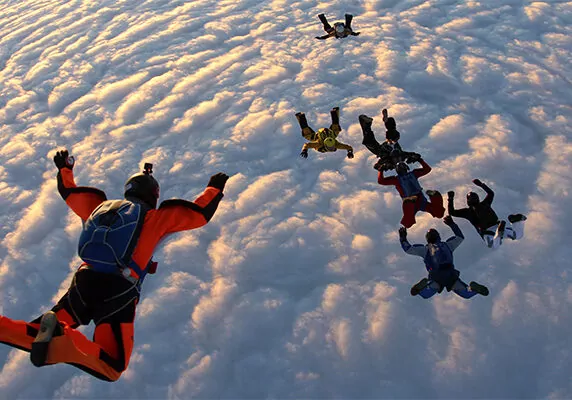A paramotor is a motorized paraglider that is used for flying. A propeller, typically powered by a small two-stroke engine, is strapped to the back of the pilot. A paraglider is attached to the pilot with carabiners. To take off, the pilot gets a running start, then gives the paramotor some gas via a hand-held throttle to gain lift. Taking off and landing are typically performed in an open field.
It is important to note that this article is a review of general information, and is not intended to be a guide in any manner for paramotoring. Seek more information from trained professionals.
One of the most interesting aspects of paramotoring is that it is not regulated by the Federal Aviation Administration (FAA). It is self-regulated. This means that paramotor pilots do not need clearance to take off or land. In fact, they do not need to communicate with a flight tower at any point. There are no formal certification requirements for paramotor pilots. However, training is strongly suggested by the United States Powered Paragliding Association. The Association directs people to FAA guidelines. It is important to review the resources at this site. See USPPA’s website for more information.
Because paramotoring is not regulated, one might think all they need to take flight is some training and a few thousand dollars’ worth of equipment. Since anyone can do it, is paramotoring actually safe?
If you want to take flight with a paramotor, learning the basics is a must.
A paramotor is a relatively simple flying machine, consisting of only a harness, engine, and paraglider. The paramotor pilot controls speed with a hand-held throttle. To control direction and altitude, a pilot must maneuver the paraglider, just as one would do while flying in a standard, non-motorized paraglider. However, unlike a paraglider, the use of thermals (hot air) to gain more altitude is not required.
The modern paramotor was developed in the 1980s. A paramotor’s propeller is designed for high speeds and high revs. The wing, or parasail, has trimmers which allows the pilot to adjust the angle of attack in order to ascend or descend. When trimmed out, the paramotor can achieve maximum speed, allowing the pilot to gain altitude. Trimmed-in wings allow the pilot to slow down and descend. A pilot can change the angle of attack via a pulley system, operated by their hands and feet.
Like all forms of flight, takeoff and landing are the most challenging aspects of flying a paramotor. We already mentioned that takeoff requires a running start. Failure to gain enough speed can result in aborting the takeoff. The heavier the pilot, and the heavier the equipment, the more difficult it can be to gain the speed required to take off. Landing is just as difficult. Pilots make an effort to always land downwind and in open fields. Properly controlling the paraglider, which is known as “kiting,” must be mastered to land safely. When pilots do land, they generally touch down and run along the ground to slow to a stop.
When not in use, all flying gear and equipment can be stored in a closed trailer or garage—you don’t need a hangar like you would owning an airplane!
Paramotoring is self-regulated, but that does not mean you should take flight without first taking lessons.
There is no doubt that, if you want to fly, paramotors offer one of the lowest barriers of entry. One of the reasons for this is that paramotoring is unregulated.
Technically, anyone can buy a paramotor, strap it on, and take off without any previous experience—but you should not do that. It is critically important that you take paramotoring lessons from an experienced professional prior to setting off on your own.
The good news is that experienced paramotors are willing to lend a helping hand. For example, there are multiple paramotor training facilities in California. No, these facilities are not regulated by any governing body. Paramotoring is a fairly niche sport. But what the sport lacks in popularity it more than makes up for in passion. Experienced paramotorists who teach at training facilities claim to have the knowledge to help those new to sport quickly how it is done.
If you are new to the sport and looking to take some training classes, here are some basic skills you should learn from trained professionals:
- What gear you need
- How a paramotor works
- How to handle the paramotor on the ground
- How to accelerate and decelerate
- How to take off
- How to ascend
- How to control the paramotor while flying
- How to descend
- How to land
- How to maintain your equipment
- Thoroughly review and understand information on the USAAP website
Paramotoring is self-regulated, but that does not mean you should take flight without first taking lessons from trained professionals.
Available injury statistics suggest paramotoring can be dangerous, but the unregulated nature of the sport makes safety data unclear.
Because paramotoring is not regulated, injury statistics are not widely available. The United States Powered Paragliding Association (USPPA) acts as the unofficial charity of paramotoring in the United States. The USPPA website does maintain a database of self-reported incidents.
According to the USPPA, 471 paramotoring incidents have occurred since 2001. Of these self-reported incidents:
- 30 resulted in a pilot or passenger fatality
- 84 resulted in major injury requiring hospitalization
- 126 resulted in minor injuries
- 177 resulted in no injuries
A total of 471 self-reported paramotor incidents since 2001 is an average of 24 per year. Keep in mind that these are self-reported and the USPPA’s database is an unofficial record. The available injury statistics indicate that paramotoring may be dangerous, but because it is not regulated, unreported incidents have likely occurred, making the statistics possibly unreliable.
So, if you want to fly a paramotor, how do you remain safe?
Take lessons. As we mentioned, lessons from trained professionals is one way to learn and possibly diminish the chance of injury. Do not attempt to fly before taking classes with an experienced instructor, and only fly on your own when you are comfortable doing so.
Buy quality gear. Paramotor gear should cost anywhere from $5,000 to $15,000. Talk to a trained professional about the right gear for you.
Fly in good weather conditions. Rain and wind can cause equipment failure and make it difficult to control a paramotor. Pay close attention to the weather and only fly in calm winds with no rain.
Never fly at night. Paramotorists should never fly at night. At night, you can not be seen by other aircraft. You also cannot see the ground and where to land when in the air at night. When you fly during the day, be sure to land before the sun goes down.
Anyone can fly a paramotor—that’s what makes the sport so intriguing! But don’t be fooled by the low barrier of entry. Paramotoring can be dangerous especially if you do not know how to fly. Take lessons from a professional, buy quality gear, and always err on the side of caution when flying.



